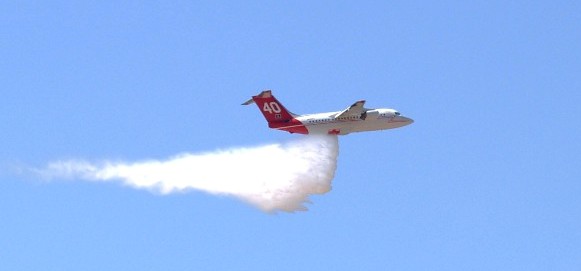
Neptune Aviation has been putting their jet-powered BAe-146 air tanker through a second round of drop tests over the last week at the Missoula, Montana airport. The video below was shot by Bill Moss on July 11, 2011. To watch it, your best bet is to select “full screen”.
About the most recent tests, Mr. Moss told us:
The water drops were multiple passes testing each of the 4 drop tanks separate and then later they did combination drops using pairs of the 4 tanks. During the winter modification were made to the delivery outlets to improve the pattern coverage.
The design of Neptune’s tank system, including the number of tanks and the method for discharging the retardant through the nozzles has not been confirmed. As a point of reference, check out the photos we posted July 30, 2009 of Evergreen’s 747 Supertanker, showing the four external nozzles, and the interior, with the numerous retardant tanks.
The BAe-145, serial number E2049, first showed up at Neptune’s facilities in the spring of 2010. A Canadian company, Tronos, converted the jetliner to an air tanker, and Neptune conducted drop tests of the aircraft in July of 2010. Here is one of the photos that Bill Moss took of that first series of Neptune’s tests.

During the formal drop tests with retardant in 2010, Neptune’s BAe-146 did not meet the Interagency Air Tanker Board’s standards, being unable to obtain adequate line lengths for the higher coverage levels.
We were not able to find anything about the BAe-146 on Neptune’s web site, but there was this:
Our impeccably maintained Lockheed P2V fleet provides our customer with a safe, useful, and effective firefighting tool while we transition into a modern platform.
Minden
Minden Air, based at Minden, Nevada, has purchased three BAe-146 jets. One of them, serial #E2033, was scrapped, another, serial #E2106 according to Planespotters is “stored”, and the third, serial #E2111 is being converted into an air tanker. Here is an excerpt from a blog on Minden’s web site which also has some photos of the conversion process:
Slow and Steady Wins the Race
January 31, 2011
The BAE-146 Air Tanker project is moving along at a steady pace. Making certain the job is done right, everyone is ensuring the i’s are dotted and the t’s are crossed. Minden Air Corp is not just focused on the goal, but also highly dedicated to the proper processes. This attention to detail, and determination will ultimately be rewarded with a stellar product to provide to the US Forest Service and the World.
A brief description of the BAe-146 air tanker from Minden’s site:
The BAE-146 Air Tanker is the next generation initial attack aerial firefighter, fully capable of operating in today’s infrastructure with greater capability, speed, and range. Simply put, the BAE-146 will lead the Air Tanker industry into the future while refining the product. Key attributes of the BAE-146 Air Tanker include:
GPS interactive, 3000 US Gallon, Constant Flow tank
- Proven jet reliability
- Low speed maneuverability
- Great airfield performance
- Superior steep approach capabilities
- Excellent initial attack range and speed
- Small noise footprint
To aid in protection of natural resources and the public, today’s wildland firefighting environment demands a new aircraft with great qualities that can fit within a established system. The BAE-146 is that aircraft…the aircraft Minden Air Corp will use to navigate the industry’s future.
According to a list maintained by NIFC, in 2010 Minden had two conventional P2V air tankers under exclusive use contracts with the federal government. Neptune had nine P2V’s and Aero Union had eight P-3A’s under contract. This is a total of 19 large air tankers, compared to the 44 we had in 2002.
Thanks go out to Bill for the video and photos.

